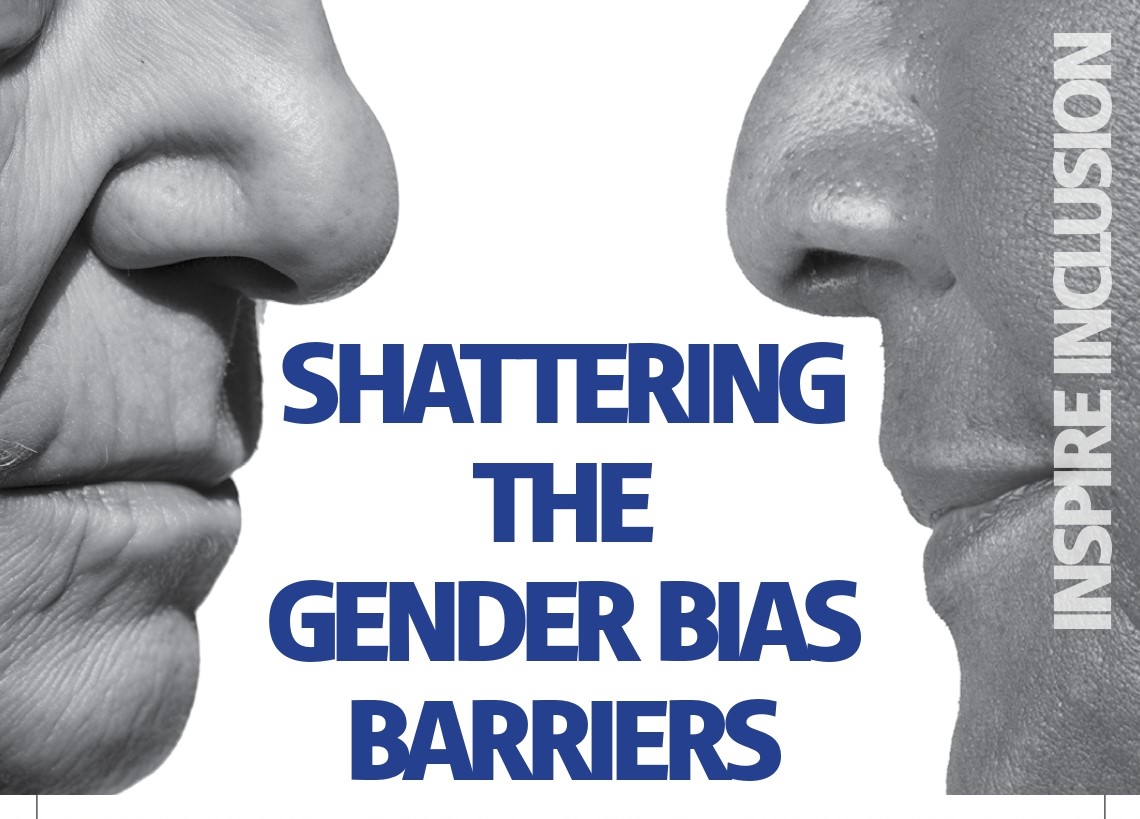SHATTER THE GENDER BIAS BARRIERS
By Amy Diehl, PhD
Chief Information Officer | Wilson College, and Gender Equity Researcher

LINKAGE Q2 (2024) - INSPIRE INCLUSION
Women in Trinidad and Tobago comprise 44.5% of managerial positions and make up only 29% of parliament. Across Latin America and the Caribbean, just 11% of companies have a woman general manager. These statistics are not dissimilar to the United States, where women comprise 40% of manager positions, but only 28% of C-suite positions as of 2023.
These disparities for women in leadership—especially top leadership—are the direct result of workplace gender bias. Even though most governments have laws prohibiting overt forms of sex discrimination, impediments to women’s advancement are still built into standard business practices. Workplace gender bias is comprised of barriers hold women back while pushing men forward.
Collecting data to identify the extent of a problem is crucial. To that end, my co-authors (Drs. Leanne Dzubinski, Amber Stephenson, and David Wang) and I created a validated scale to measure workplace gender bias. Organisations can deploy the Gender Bias Scale for Women Leaders to their women employees to measure bias across six core factors and 15 subfactors. These factors represent barriers to women’s workplace equality.
After creating this scale, Dr. Leanne Dzubinski and I continued the research. Having discovered the six core barriers of gender bias, we wanted to study more industries and identify additional sub-barriers. The work is published in our new book: Glass Walls: Shattering the Six Gender Bias Barriers Still Holding Women Back at Work.
Dr. Dzubinski and I wrote the book we wish we had when we started in the workforce. Not only does Glass Walls comprehensively detail barriers women face at work, it also provides specific strategies for overcoming these barriers—for individual women, allies and leaders. We also give names to barriers that were not previously named, such as role incredulity, credibility deficit and diminishment.
The six gender bias barriers are male privilege, disproportionate constraints, insufficient support, devaluation, hostility and acquiescence.
Male Privilege
Male privileged workplace cultures assume that men are the leaders, control the resources and set the standards for the culture. Women may enter this environment, but only in ways not threatening to men’s privilege. In this culture, men act as gatekeepers controlling which women have access to positions and the bounds of their leadership and opportunities. Men may set women on a glass cliff, putting them in charge when the organisation is in a state of crisis. It is a risky situation where the woman will be blamed and let go if she doesn’t perform the miraculous. Another example of male privilege is role incredulity, where people assume women are not in charge and mistake them for traditionally female roles. When I was part of AMCHAM Trinidad and Tobago panel in 2021, I was alongside a woman who was a director of security. When she met new people, they often assumed her to be the secretary. That’s role incredulity.
Disproportionate Constraints
Women are subject to disproportionate constraints, which require them to act in certain ways, subordinate to men and playing supportive roles to male power. They are subject to unequal standards, having to over-prepare and work twice as hard to succeed. To ensure that women do not deviate from behaviour and performance expectations, they are subject to scrutiny. Their dress and appearance may be a focus, and their job performance may be scrutinised in ways above and beyond that of the men.
One type of constraint that is almost (unfortunately) ubiquitous is muting women’s voices. There are new terms (coined by others) that relate to this phenomenon.
• hepeat: when a woman suggests an idea and it's ignored, but then a man says same thing, and everyone loves it
• bropropriate: when a man repeats a woman’s idea and takes credit for it
• manterrupt: when a man unnecessarily interrupts a woman
• mansplain: when a man interrupts a woman to explain to her something that she knows more about than he does
Insufficient Support
Women often find they are not supported to the same extent as men. They lack access to mentors, sponsors and networks that would support their advancement. They may also be excluded from informal networks, unofficial social events and even formal professional events. Even when women are invited to unofficial events, like going to the bar after work or golfing on the weekend, they may not have interest in attending or the time to do so, especially if they have caretaking responsibilities.
Devaluation
Devaluation consists of attempts to make women seem less important and detract from their authority. Women’s contributions may be devalued, if they are acknowledged at all. It may be assumed that they will handle the office housework, such as taking notes in a meeting, serving on committees, organising the office party, cleaning the office refrigerator or microwave, or helping a colleague to improve a presentation or project. Such activities are very helpful in keeping everything running smoothly. But they are rarely officially recognised or rewarded. Diminishment is another common way that women are devalued. It includes put-downs, pet names, disparagement, belittling, or assuming a woman's opportunities are the result of her gender only (i.e. affirmative action). Devaluation also includes credibility deficit where women’s statements are not believed.
Devaluation is often reflected in women’s pay, in which they earn less than men for similar work. Salary inequality is a global phenomenon. As of 2022, Belgium had the lowest gender pay gap of 1.2%, meaning that women earned 98.8% of men’s salaries. The European Union average was 10.8%. The gap in United States was 17%. South Korea’s gap was very high: 31.2%. By comparison, the gender pay gap in Trinidad & Tobago was 25% as of 2021. Not paying women equally to men is just another way their contributions are devalued.
Hostility
Hostility is an active resistance to women’s presence and an attempt to keep them in their supposed place in the gender hierarchy. They may face discrimination such as being denied opportunities for challenging assignments, job-related travel, and promotions. They may face harassment including sexual harassment. And they may face retaliation for reporting harassment or discrimination.
Not all harassment comes from men. To protect themselves, some women may reinforce sexist norms against other women. Queen bee behaviour occurs when women at the top fail to help other women or actively prevent their promotion. It’s usually driven by insecurity, when women are worried that their position may be taken away at any moment. Made to second-guess themselves, women may try to maintain their own dominance by keeping other women down. This behaviour stems from organisational cultures that don’t “have space” for more women in certain roles or at top leadership levels.
Acquiescence
When the barriers are so prevalent, women may internalise them and adapt to the limitations. They acquiesce. They may stay silent on workplace sexism to maintain loyalty to the male leaders as a self-protection mechanism. Women may also limit their aspirations, deciding that they are not capable of advancement or that they are unwilling to deal with the pressures of professional advancement that men do not face. Limiting one’s own aspirations is the outcome of having to deal with all the other barriers.
Solutions
While workplace gender bias is a pernicious problem, it is also solvable. We all can be part of the change. Here are some actions for leaders, allies, and individual women.
Leaders
• Replace competition with collaboration inside your organisation so that your employees are incentivised to help each other.
• Measure success by goals, instead of by time spent in the office. In other words, measure the work outputs instead of the inputs.
• Implement cooperative reward structures that recognize all contributions toward organisational goals, including office housework.
• Provide options for remote and flexible work to boost employee motivation and performance. Maximise employee autonomy to decide where and when the work gets done.
• Ensure there is transparency in decision-making. Full discussion and decisions should occur when stakeholders are present, as opposed to taking place in informal conversations or out on the golf course.
• Eliminate cultures of overwork. Disincentivising working beyond normal schedules will allow everyone to have better work-life balance and set an equal playing field for women who cannot work extra hours due to caretaking responsibilities.
Allies
• Call out bias publicly and immediately when it happens.
• Advocate for women in all hiring and promotional decisions.
• Flip it to Test it. Consider if a criticism of a woman would be said of a man. For example, would a man be criticised for being too bossy, too assertive or too aggressive?
• Actively support women. Be a mentor, a sponsor, or a safe and confidential listening ear.
Women
• Learn about bias so you can recognise it if it happens to you.
• Do not take bias personally. It is not about you, and it is not unique to you.
• Build your support network including other women and male allies.
• Maintain your perspective and practice self-care. Life is not all about work.
• Have alternatives and use them. If you feel stuck in a toxic environment, consider your options. You could apply for another position, go back to school, or perhaps work for yourself.
When we each do our part, we can shatter gender bias. Our workplace will become healthier for women, which means women can spend their energies on advancing the organisation instead of constantly fighting bias.
ABOUT THE AUTHOR

Amy Diehl, PhD, is an award-winning information technology leader, currently serving as Chief Information Officer at Wilson College in Chambersburg, PA. She is also a gender equity researcher and author of the new book Glass Walls: Shattering the Six Gender Bias Barriers Still Holding Women Back at Work. Her writing has appeared in numerous scholarly journal articles and book chapters as well as in Harvard Business Review, Fast Company, and Ms. Magazine. She is also a sought-after speaker, consultant, and lawsuit expert witness. You can visit her online at https://amy-diehl.com. She was the Closing Keynote Speaker at the Second AMCHAM T&T ESG Conference.